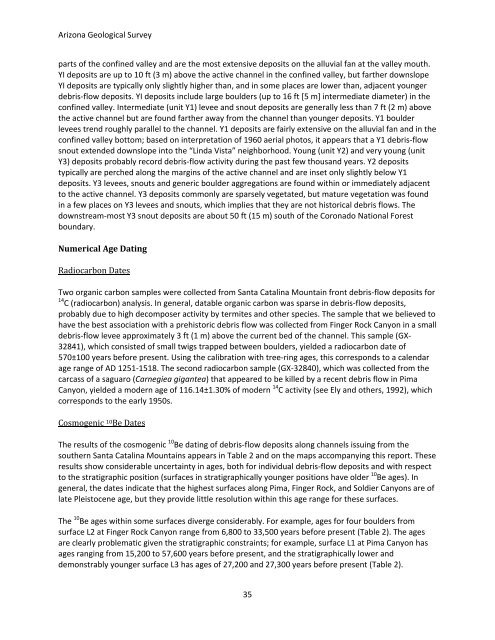Arizona Geological Survey OPEN-FILE REPORT OFR 08-06
Arizona Geological Survey OPEN-FILE REPORT OFR 08-06
Arizona Geological Survey OPEN-FILE REPORT OFR 08-06
You also want an ePaper? Increase the reach of your titles
YUMPU automatically turns print PDFs into web optimized ePapers that Google loves.
<strong>Arizona</strong> <strong>Geological</strong> <strong>Survey</strong><br />
parts of the confined valley and are the most extensive deposits on the alluvial fan at the valley mouth.<br />
YI deposits are up to 10 ft (3 m) above the active channel in the confined valley, but farther downslope<br />
YI deposits are typically only slightly higher than, and in some places are lower than, adjacent younger<br />
debris‐flow deposits. YI deposits include large boulders (up to 16 ft [5 m] intermediate diameter) in the<br />
confined valley. Intermediate (unit Y1) levee and snout deposits are generally less than 7 ft (2 m) above<br />
the active channel but are found farther away from the channel than younger deposits. Y1 boulder<br />
levees trend roughly parallel to the channel. Y1 deposits are fairly extensive on the alluvial fan and in the<br />
confined valley bottom; based on interpretation of 1960 aerial photos, it appears that a Y1 debris‐flow<br />
snout extended downslope into the “Linda Vista” neighborhood. Young (unit Y2) and very young (unit<br />
Y3) deposits probably record debris‐flow activity during the past few thousand years. Y2 deposits<br />
typically are perched along the margins of the active channel and are inset only slightly below Y1<br />
deposits. Y3 levees, snouts and generic boulder aggregations are found within or immediately adjacent<br />
to the active channel. Y3 deposits commonly are sparsely vegetated, but mature vegetation was found<br />
in a few places on Y3 levees and snouts, which implies that they are not historical debris flows. The<br />
downstream‐most Y3 snout deposits are about 50 ft (15 m) south of the Coronado National Forest<br />
boundary.<br />
Numerical Age Dating<br />
Radiocarbon Dates<br />
Two organic carbon samples were collected from Santa Catalina Mountain front debris‐flow deposits for<br />
14 C (radiocarbon) analysis. In general, datable organic carbon was sparse in debris‐flow deposits,<br />
probably due to high decomposer activity by termites and other species. The sample that we believed to<br />
have the best association with a prehistoric debris flow was collected from Finger Rock Canyon in a small<br />
debris‐flow levee approximately 3 ft (1 m) above the current bed of the channel. This sample (GX‐<br />
32841), which consisted of small twigs trapped between boulders, yielded a radiocarbon date of<br />
570±100 years before present. Using the calibration with tree‐ring ages, this corresponds to a calendar<br />
age range of AD 1251‐1518. The second radiocarbon sample (GX‐32840), which was collected from the<br />
carcass of a saguaro (Carnegiea gigantea) that appeared to be killed by a recent debris flow in Pima<br />
Canyon, yielded a modern age of 116.14±1.30% of modern 14 C activity (see Ely and others, 1992), which<br />
corresponds to the early 1950s.<br />
Cosmogenic 10 Be Dates<br />
The results of the cosmogenic 10 Be dating of debris‐flow deposits along channels issuing from the<br />
southern Santa Catalina Mountains appears in Table 2 and on the maps accompanying this report. These<br />
results show considerable uncertainty in ages, both for individual debris‐flow deposits and with respect<br />
to the stratigraphic position (surfaces in stratigraphically younger positions have older 10 Be ages). In<br />
general, the dates indicate that the highest surfaces along Pima, Finger Rock, and Soldier Canyons are of<br />
late Pleistocene age, but they provide little resolution within this age range for these surfaces.<br />
The 10 Be ages within some surfaces diverge considerably. For example, ages for four boulders from<br />
surface L2 at Finger Rock Canyon range from 6,800 to 33,500 years before present (Table 2). The ages<br />
are clearly problematic given the stratigraphic constraints; for example, surface L1 at Pima Canyon has<br />
ages ranging from 15,200 to 57,600 years before present, and the stratigraphically lower and<br />
demonstrably younger surface L3 has ages of 27,200 and 27,300 years before present (Table 2).<br />
35
















